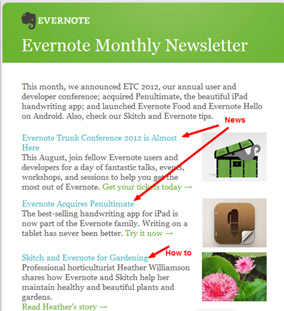
If you write a business blog and would like to see better results from it, I believe you will find the following 8 blogging tips really useful. They are based on my own experiences, having grown Jim’s Marketing Blog from zero, to one of the world’s most popular marketing blogs.
Let’s get started with tip number 1.
1. Write when you have something useful to share. Be useful often
Very few bloggers seem to understand one of the most basic facts of blogging. It’s simply this: You can’t expect people to keep returning to your blog, if you don’t.
For example, if a reader finds a new, useful post on your blog today, then returns in a few days and there’s nothing new, then returns a few days later and still nothing new – you stand a great chance of losing their interest. Conversely, if they find something useful on your blog every few days, they’re extremely likely to keep returning. That’s how you become part of their world. That’s how they start getting to know you.
When you publish posts infrequently, it’s almost like starting from zero each time. There’s little if any momentum: Momentum is essential if you want to grow your readership.
I often hear people claim that they just can’t find useful topics to blog about, on a regular basis. The thing is, these same people have no trouble finding useful things to say to their clients, contacts and friends, every day! Writing is like talking. If you can talk regularly about your topic, there’s no reason why you can’t write about it too. I believe everyone can think of something useful to share at least a couple of times a week.
The next tip takes this one step further.
2. Write as closely as you can, to the way you speak
Have you ever noticed that when you read the best blogs, it almost feels like you can hear the blogger speaking the words to you? That’s because these writers have discovered, that when you write similarly to the way you speak, you make it easier for people to connect with the person behind your posts.
In fact, allowing your personality to shine through your written words, may be one of the best kept secrets of the most successful, prolific bloggers.
3. Avoid writing ‘me too’ blog posts
Some bloggers will only write posts, which agree with what almost everyone else in their space is saying. By adding nothing new, you give people nothing to connect with. You look like a sheep. Always look for a way to add something of your own, something that shows your readers what you think and what you feel about the topic.
4. Aim to be useful
The most widely read blog posts are those, which people find useful in some way. So, give your readers something they can take away from the post and put into action.
Give them an idea, which they can chew over and then draw their own conclusions.
Give them a fresh way to look at an old challenge.
In a nutshell – The more useful you are, the more valuable your blog will be to your readers.
5. Focus on them
Yes, it’s nice occasionally to write about yourself, but if you really want to engage your readers, you need to focus on them. Talk about what’s happening in their world. Offer answers to the problems facing their industry.
There’s a big difference between writing posts that just talk about you, your product and how amazing you are – and writing posts that are all about being useful to the reader, yet contain lessons from your own experiences. In fact, it’s a great idea to share your own experiences, when offering useful examples to help make a point. I’ve done it a few times in this post. Your readers will value learning what happened when you did XYZ – it could save them time and money.
The key is to ensure the focus of the post is on helping them, rather than bragging or pushing sales pitches at them!
6. Don’t try and sell in every post
You write a business blog and the purpose of the blog is to help you build your business. It’s essential to write posts, which promote your products or services, but you need to get the balance right.
In my experience, the vast majority of your posts should be designed to offer independent value to your reader. By independent value, I mean the reader should be able to get something useful from your posts, without having to buy something from you or hire you. I write just a few posts a year, which exclusively promote my marketing services. These are sometimes called conversion posts. All the hundreds of other posts are me offering independent value.
I’m not suggesting you write as few conversion posts as me, but remember that there’s a reason people skip the ads on their TV’s. They watch TV for the programs, not the commercials. Too many conversion posts and you’ll find it extremely hard to build a great readership.
N.B: One of the reasons I write so few posts that promote my marketing services, is that I include a small excerpt at the bottom of my posts. This has a link you can use, if you want to know how I can help you grow your business or build a successful blog. Readers know it’s there and can ignore it, until they want to find out more. It’s out of the way, until it’s needed.
7. Keep it human
If you want your readers to connect with you, you need to be approachable. The reader needs to know that if they email or call you, you will welcome them. This means humanizing the relationship between you and your readers.
Here are a few examples, based on what I do.
- I respond to every comment, which needs a reply.
- When I reply, I try and always include the name of the person who commented.
- If I notice someone commenting here for the first time, I welcome them to the blog. And I genuinely mean it.
- Everyone who reads this blog via email, can send me a personal email, by simply replying to it! Your reply goes direct to my inbox, so we can have a more private connection. If it isn’t spam, they get a response and they know I love to hear from them. Many readers exchange emails with me several times a week. It’s wonderful. I love hearing from you. If you’d like that deeper connection with me, you can get all future posts via email, for free, by subscribing here.
8. Never aim for perfect
If you do, you’ll seldom publish anything. The perfectionist mindset places the bar impossibly high. It tells us that we have to cover every point, counter every possible argument and do all this, in an engaging way. I’ve written thousands of blog posts and not only are none of them perfect, none of them would ever have been published had I been aiming for perfect.
That’s the thing about the perfectionist mindset. It stops us from even getting started.
Here’s what we know about your marketplace: None of them are expecting perfection from you. Not one. As I mentioned earlier, what people want is something that’s useful, something of value. Something they can quickly read and get at least one insight, answer or nugget of information from.
In closing
A business blog can either be a waste of time or an enormously valuable business asset, depending on what you do with it. I hope you find something here, which helps your blog join the latter of those two groups.
To your success!



 Here’s why this matters: By ‘letting us in’ on what the team are up to and allowing us to see how the company is developing, we feel like part of their community. We feel a deeper connection with them. We get a picture of the people and brand behind the product. Very few small business newsletters do this and as a result, they miss out on developing a stronger connection with their readers.
Here’s why this matters: By ‘letting us in’ on what the team are up to and allowing us to see how the company is developing, we feel like part of their community. We feel a deeper connection with them. We get a picture of the people and brand behind the product. Very few small business newsletters do this and as a result, they miss out on developing a stronger connection with their readers.

